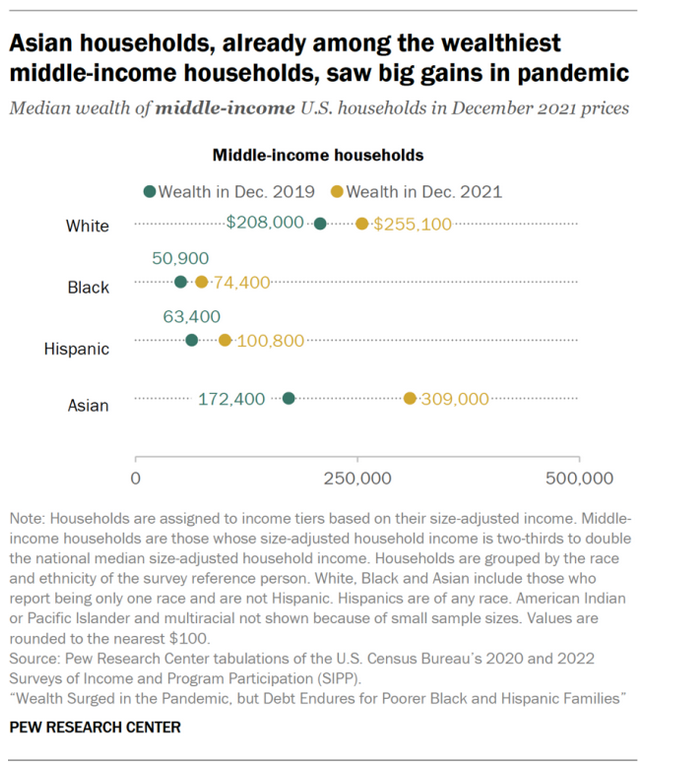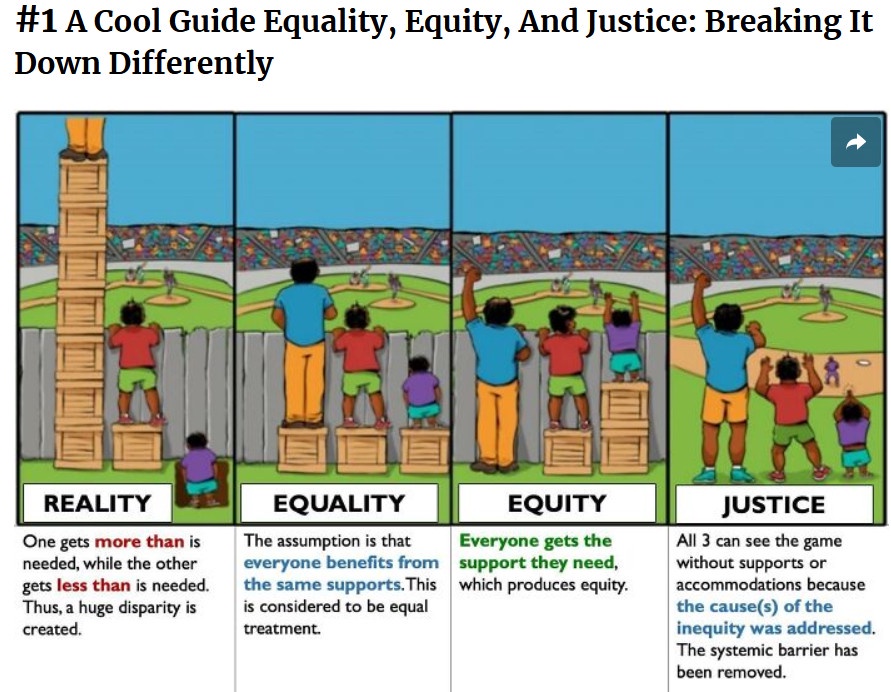Anti-intellctualism, Trump admin, and the threat to democracy.
Response to dismantling the D.O.E., DEI, and some civil rights topics
… the issue isn’t that conservatives are bringing up social-media concerns. That’s not it at all. The issue is that these social media websites have audience sizes the world has never before seen. The issue of social media and social networks on digital platforms has never been more important for effective democracy and political advocacy, especially in a world so soon out of the civil rights era, that fundamental civil rights are at stake. Let’s discuss some of these now.
Preface
This country is under attack. Here’s why it’s not coming from the ivory tower, but from the oval office. I’ll give you evidence that it’s not from the press or from the schools, teachers, or liberals who promote education. Feel free to interpret the bias however you want. That said, I’d urge the reader to ask themselves why the economy has been in a stand-still for years, why rents are up, buying a house is impossible for most millenials, and why the government would have cause to lie about job statistics to keep the S&P500 and other wall st institutions from addressing true concerns for the future of America.
We take it for granted that because America has been around for centuries, it will continue to be the best country in the world. This may not be the case. I’m not saying this to give you more anxieties than you already have. I’m saying this because there are several reasons that seem obvious to me, and I’m going to tell you why attacking and scapegoating education and free press is not the solution.
First, the Declaration of Independence is not a legal document. It is a description of the reason why we seceeded from the colonial system of oppressive taxation and serfdom of the kingdom of England. The Constitution was signed on September 17th, 1787. This document, and later the Bill of Rights, enshrines some fundamental rights for U.S. citizens that would later be extended to members of all races and of both sexes.
Freedom of speech and freedom of the press
The constitution offers us rights to say “anything” we want (there are some situations for benefit of public safety where certain rights do not permit us to interfere with the rights of others, such as shouting “fire” in a movie theater). This is part of the First Amendment rights rights that are extended to both U.S. Citizens and resident and non-resident aliens. Most of us agree that the “Freedom of Speech” is a modern and important right for the proper functioning of society, as well as democracy. Consider the opposite: if you or I can be coerced into saying things (or not saying things) against our will, or because of expressing viewpoints that run contrary to other U.S. citizens or even politicians, then something may be dreadfully wrong.
How would you like it if I told you I was being censored from saying “Biden is old, had memory problems, and is overly concerned with popular opinion and the politics of the suppression of conservative viewpoints?” If I’m not allowed to say that another citizen, or even a person in position of power is acting bad, then how will anyone be able to report a crime and have the police investigate it? I’m not accusing the government under one political party of illegal behavior (though they do, both parties) or being better than another administration. I’m not picking a side in this argument. Even though I am trying to make a point about “modern” 2020s conservatism, you have thick skin so you can take it, right?
Does the First Amendment apply to citizens and non-citizens alike in the U.S.A.?
A resident alien is someone with a Green Card. They have similar rights to U.S. Citizens such as the freedom from improper search and seizure by the police. As many believe, this doesn't 'detract' from the rights of U.S. Citizens to afford this benefit to resident and non-resident aliens, temporary workers, and even illegal immigrants. What this does is force the police to have better practices and standards for proving individual guilt, rather than circumstantially compromising 'evidence' that such as planting drugs, improper detention and coerced confessions, and more.
That said, the “memory problems” weren’t the biggest issue with the Biden administration. It wasn’t CHIPS or clean energy, or other policy boondoggles. The problem with Trump isn’t that he is popular or unpopular. It isn’t even the allegations of womanizing and supporting/defending racist or ableist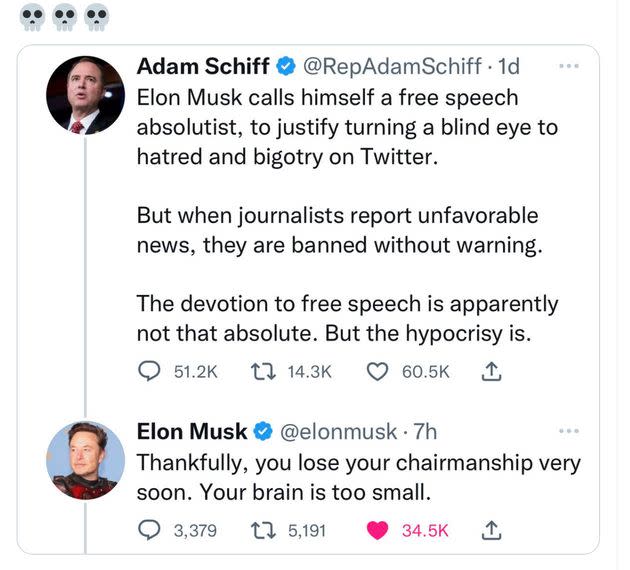 Elon insulting a congressman about his brain size, in reference to selective censorship on Twitter slogans and tweets on those subjects by Elon Musk.
Elon insulting a congressman about his brain size, in reference to selective censorship on Twitter slogans and tweets on those subjects by Elon Musk.
The Trump administration’s thoughts on ableism
The Hill wrote an article describing a “deleted tweet” The Hill’s account of Elon deleting this tweet is corroborated by Yahoo, Fox, others. There is no single source information that “must be trusted”, making fact checking more difficult. where Elon accussed a sitting congressman of having a ‘small brain’, which is an allusion to an old eugenics euphemism
The Hill’s account of Elon deleting this tweet is corroborated by Yahoo, Fox, others. There is no single source information that “must be trusted”, making fact checking more difficult. where Elon accussed a sitting congressman of having a ‘small brain’, which is an allusion to an old eugenics euphemism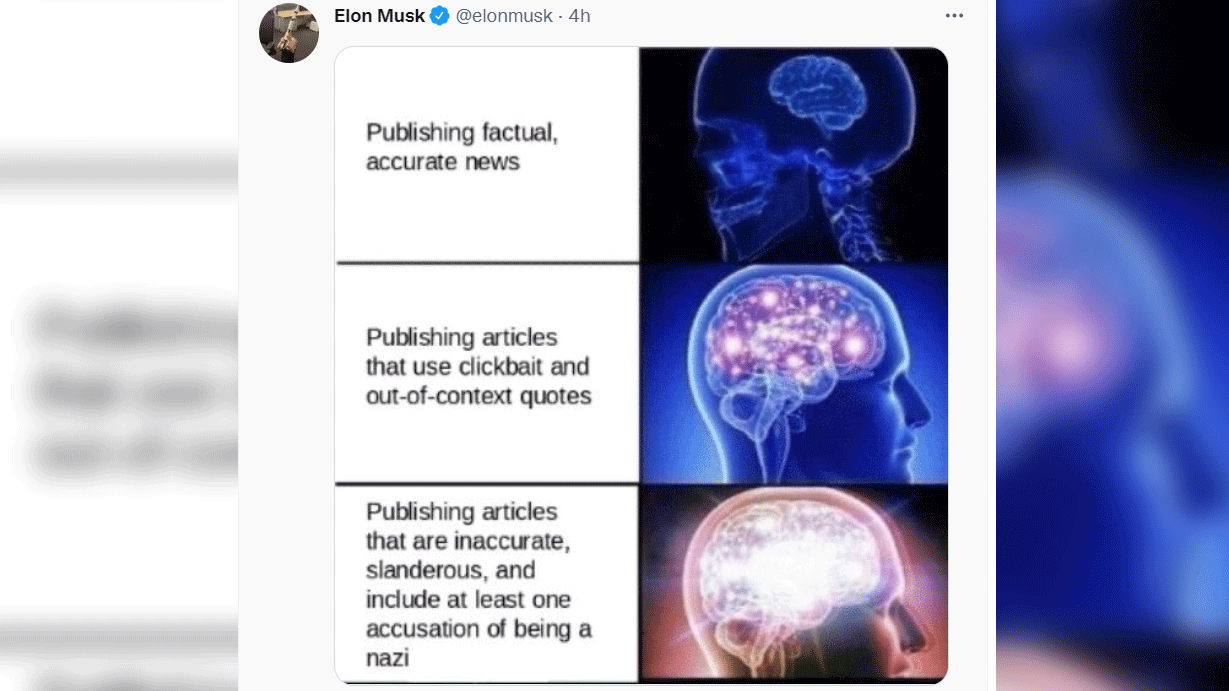 Here is Elon being defensive about being labeled a Nazi sympathizer and belief that persons of color, or women, other minority groups have smaller brains and are thus less able to think than ‘big brain’ males. (If you’re a male, you’re valid, unique and have dignity even when the world doesn’t make you feel that way. That said, your value and uniqueness doesn’t come from being a male.)
Here is Elon being defensive about being labeled a Nazi sympathizer and belief that persons of color, or women, other minority groups have smaller brains and are thus less able to think than ‘big brain’ males. (If you’re a male, you’re valid, unique and have dignity even when the world doesn’t make you feel that way. That said, your value and uniqueness doesn’t come from being a male.)
Why does "deleting" tweets matter?
Deleting a tweet suggests guilt or shame. Deleting a tweet where you insult someone not by the caliber of their thoughts or the merits of their actions, but by something like the color of their skin, their biological sex or gender, their appearance, or their 'brain size' is not just bigoted, it's a form of hate-speech. Deleting information from the internet suggests manipulation and guilt associated with something said. It could also be used to reference something that was never said, such as in a photoshopped image. In this example, Googling for "Elon Musk Adam Schiff brain comment" Fox News, The Hill, the Washington Examiner, and Yahoo News, also claim the tweet was deleted. reveals a number of new outlets where reporters reference the same deleted Tweet, the same text of the tweet, and the same deletion event. It's likely that because Fox News said it's deleted and the Hill, the Washington Examiner, and Yahoo news (lol) report the same event, that there is some basis that the tweet existed and was live and was then deleted for containing offensive or legally dubious content.
Fox News, The Hill, the Washington Examiner, and Yahoo News, also claim the tweet was deleted. reveals a number of new outlets where reporters reference the same deleted Tweet, the same text of the tweet, and the same deletion event. It's likely that because Fox News said it's deleted and the Hill, the Washington Examiner, and Yahoo news (lol) report the same event, that there is some basis that the tweet existed and was live and was then deleted for containing offensive or legally dubious content.
More recently in the news, Trump has been attacking minorities and civil rights of minorities by describing several recent (Feb 25) plane crashes as the result of DEI. Mother Jones summarized sentiment from recent press conferences and ableist and racist statements about the FAA air traffic controllers. Civil rights groups “Center for Disability Rights”, “American Association of People with Disabilities” and “National Disability Rights Network” all released blog articles concerning the recent ableist remarks and associated violence-enabling rhetoric issues by the President.
Elon cutting back Freedom of Speech on Twitter/X
The ACLU (03/2024), the Center for Countering Digital Hate (08/2023), the non-profit Media Matters (11/2023), the New York Times (09/2023), and several independent journalists including Donie O’Sullivan (CNN), Ryan Mac (NYT), Drew Harwell (Washington Post), Micah Lee (The Intercept), and Aaron Rupar (from NPR, 12/2022) have been either suspended from twitter/x, or hit with frivolous SLAPP suits. The Hill covered some of these stories starting back in 2022.
From wikipedia - Strategic Lawsuit Against Public Participation (SLAPP)
In a typical SLAPP, the plaintiff does not normally expect to win the lawsuit. The plaintiff’s goals are accomplished if the defendant succumbs to fear, intimidation, mounting legal costs, or simple exhaustion and abandons the criticism. In some cases, particularly in the context of investigative journalism, repeated frivolous litigation against a defendant may raise the cost of directors and officers and other liability insurance for that party, interfering with an organization’s ability to operate.
The goal of these lawsuits and suspensions is to deplatform, silence, and effectively censor critics on Elon’s social media site Twitter/X, or to restrict the audiences by which they can deliver their criticisms effectively on controversial issues such as hate speech, bias in algorithms/social media, and more. Make no mistake: it’s very effective. This is producing some of the largest online censorship in real time. It’s a trend I’ve seen in several political and news subreddits. It’s not just me in an echo chamber here, social media bias has been in the news for about a decade now. And there is still largely the same conservative lean on the appeals, court cases, and lawsuits against large social media outlets such as Facebook, Twitter, and others.
That being said, the issue isn’t that conservatives are bringing up social-media concerns. That’s not it at all. The issue is that these social media websites have audience sizes the world has never before seen. The issue of social media and social networks on digital platforms has never been more important for effective democracy and political advocacy, especially in a world so soon out of the civil rights era, that fundamental civil rights are at stake. Let’s discuss some of these now.
Civil Rights Overview
I'm a U.S. Citizen and I want to know if Civil Rights are my rights. What is the deal with civil rights?
Okay! Expand the notes here for a more thorough review on civil rights history and civil rights afforded to you through the Civil Rights Acts of 1957, 1960, 1964, and beyond.
If civil rights are weakened, does it effect me?
YES! Civil Rights apply universally, they don't affect only persons of minority ethnicities; they effect white persons from European/Caucasian ancestry equally. Am I sure? YES!
This isn't some new-age socialist conspiracy! You have civic and social rights afforded to you by the government such as public health programs, disaster relief, access to government funded research, and protection from employment discrimination about your faith, your ethnicity, your politics, and so much more. Anyways...
Okay, so if it affects me, then how can I benefit from learning more about civil rights?
In the most simple way possible, all Americans and migrants to the U.S.A. should learn about American Civil Rights even from the beginnings of which responsibilities were given to the government by the people, and the origins of Civil Service and distinctions between politics, monarchs, parliaments, house of commons/representatives, and house of lords/senates, and Civic Duty in Europe. English government and representation has at times, been modeled after Imperial Chinese exams for government positions.
Government officials who passed the exams were in charge of large numbers of regional governors, who had abilities and knowledge to properly represent local, regional interests upwards, towards the central Imperial government for allocation of its funds. For a more general discussion of civics and goverment/voter responsibilities, please see the Wikipedia article on Civics
Okay, let's skip ahead for a moment to the Civil Rights Movement
Broadly speaking, Civil Rights include a number of protections for born or naturalized citizens of a country. Notable civil rights include the right to vote, the right for immunity from illegal stop and seizure by military or police, the right to an attorney, Miranda rights (anything you say can be used against you in a court of law), freedom of speech, freedom of religion, the right to a free press, disability rights, protection from discrimination in housing, employment discrimination based on pregnancy, gender, race, religion, or other features, and the right to bear arms. In modern society, these rights often extend, in part or in whole, to those from foreign countries living in a country on Work Visas, Green Cards, or other special legal permits.
Civil Rights Acts of the 1950s
Preceded by the Civil Rights Acts of 1957 and 1960, and given teeth by the DoJ Civil Rights Division and the US Commission on Civil Rights, the ruling by the U.S.A. Supreme Court in Brown v. Board of Education and the following legislation signed by President Dwight D. Eisenhower in 1957, laid the foundation for public discourse with legislative and judicial grounding for President John F. Kennedy to make Civil Rights part of main stream civic responsibilities to our neighbors.
Prior to these landmark civil rights victories, the Reconstruction and later Jim Crow eras had led to segregated public spaces, lavatories, market inclusion, and other features of society. Additionally, many African Americans were not given the same voting rights as non-black persons. The struggle of African Americans in this country has been one of the victories of civil disobedience, at the cost of suffering, generational poverty, physical violence, and generational trauma.
Skip ahead to Key civil rights issues if you would like to skip a review of why civil rights are important for you, regardless of your faith, gender/sex, or ethnicity.
In total, there are 152 provisions establishing certain functions of the government to serve and protect its citizens, or establishing specific functions and services offered to citizens in U.S. law. The U.S. Code is one group of legislations and amendments that have changed over time to protect public health, social 'welfare'/well-being, and civil rights. I encourage the reader to at least visit the impressive Wikipedia page for U.S. Code 42 to admire the wealth of functions, services, and protections afforded to you by virtue of citizenship of our great nation that protects your health and well-being through the various institutions within our government.
Looking at these articles and protections offered to me, is truly humbling considering where we've been, the fights that have been fought and won, and our civic responsibility to the government, others, and most importantly our children to protect and inquire about changes or attacks on our civil liberties.
It is no big mystery why many believe we are the greatest country on the planet. It's not our concepts of freedom, or even our education system that makes us great. It's our great history and neighborliness towards others, immigrants, faiths, and persons seeking a home and a hearth and a happiness with their families, with rights afforded to us by our civil servants and our veterans who have defended our homeland.
Wow. This was really fun to write this. Take a look below at just a handful of the 152 sections under simply U.S. Code 42 that make our lives better, whether or not we feel the impact explicitly at our wallet, we are all made equal, even if inequities still exist... but it makes us more equal in the eyes of the government who can succeed simply if these fundamental services are enshrined and protected by current and future civil servants.
Civil Rights protected under U.S. Code 42
-
ch. 1, 6a: Public Health Service
The U.S. Public Health Service (founded 1912) is a group under the Department of Health and Social Services that includes notable government functions (even if those are viewed as controversial) such as the National Institutes of Health (NIH), Centers for Disease Control and Prevention (CDC), Substance Abuse and Mental Health Services Administration (SAMHSA), and the Food and Drug Administration (FDA). The PHS was consolidated from responsibilities of the Marine Hospital Service, which originally had mandates for disease research and quarantine.
-
ch. 8: Low Income Housing and Public Works
If you own or rent housing, you may owe some of the cost you don't see to the history of protections against predatory mortgage insurance or rental insurance, or aggressively high rents to actions protecting persons from real estate owners. Have you ever heard of the Landlord-Tenant Code? How about the Fair Housing Act, part of President Truman's Fair Deal in 1949.
-
ch. 13: National School Lunch Programs (NSLP)
Over 60% of American children attending public-schools receive low-cost school lunches through the National School Lunch Program (USAFacts.org). This is currently an issue under attack by the Trump administration. Sadly, there are some in positions in government and politics and political commentary who just think that a 17.2B USD program feeding rougly 30 millionchildren per year. Like your nephew, granddaughter, your daughter's best friend, may be someone who has 2 working parents and a large mortgage, or a family with a stay-at-home mother, or the single-parent in your congregation/temple. In comparison, Big Tech, Big Pharma, and Wall Street institutions dodge about 606B USD per year. The DoD had a annual budget of 820.3B USD in 2023, close to a trillion dollars. Of major concern, the Department of Defense just failed its 7th audit in a row. The National Football League (NFL) has ~ 20.2B USD in revenue, the U.S. Trade War and Tariff system costs taxpayers about 51.1B USD.
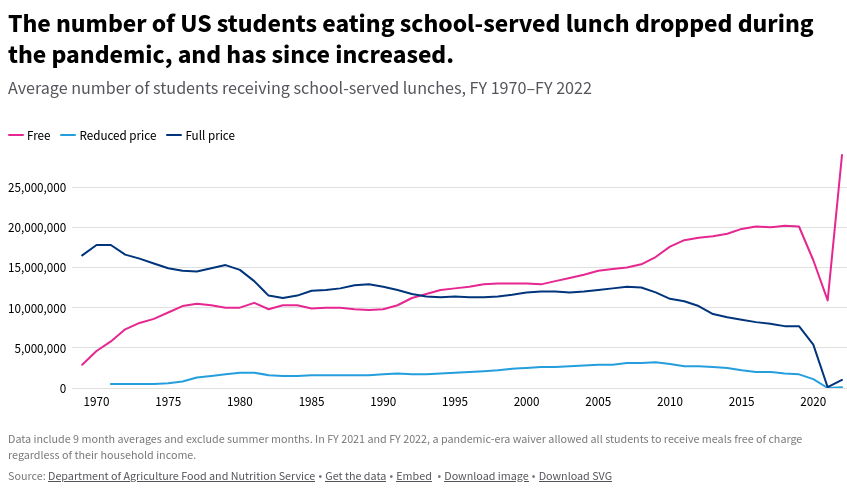
-
ch. 15: Federal Emergency Management Agency (FEMA)
This agency resides under the Department of Homeland Security, and is responsible for approximately 33.1B USD annually. FEMA was originally a consolidation of several independent functions from various government departments such as Health and Human Services, Civil Defence, Health Education and Welfare (HEW), Office of Emergency Planning, and others. By consolidating functions related to disaster preparedness under Homeland Security, engineers and response teams could be mobilized to mitigate and assist with redevelopment of disaster stricken areas. Under the second Bush administration (2000-2004) and going forward, the capacity of FEMA was strengthened to respond the devastating hurricanes Sandy, Harvey, and Irma. Responses to wildfires in California has also tested the limits of which natural disasters the agency is prepared to address.
-
ch. 16: National Science Foundation (NSF)
The NSF supervises and awards grants covering important research functions outside of specific scopes handled by other departments such as Defense, Energy, Aerospace, Health, and other fields of national importance covered elsewhere. There are many areas of overlap, and NSF research grants focus on Astronomy, Biology, Chemistry, Computer science and technologies, Earth and environment, Education research, Engineering, Material science, Physis, Social sciences, and other areas. See the NSF website focus areas for more.
-
ch. 21: Civil Rights and Privacy Protections
Chapter 21 enshrines certain rights including equal rights for all citizens under the law (no formal legal protections for socioeconomic class), equal opportunity, rights against certain discriminations, property rights, speedy and fair trials, trial by jury, adoption, and more. This is by no means a comprehensive list of civil rights protected under U.S. Code 42, but when it was amended it afforded equal rights for all citizens and paved the way for modern concepts of Civil Rights and the fairness of government processes and services afforded to citizens (and non-citizen residents) by the U.S. government.
-
Additional services covered under U.S. Code 42
In total, there are 152 provisions establishing certain functions or protecting specific functions of government services offered to citizens in U.S. law. The U.S. Code is one group of legislations and amendments that have changed over time to protect public health, social 'welfare'/well-being, and civil rights. I encourage the reader to at least visit the impressive Wikipedia page for U.S. Code 42 to admire the wealth of functions, services, and protections afforded to you by virtue of your citizenship, that protects your health and well-being through the various institutions within our government.
Key civil rights issues
Disability Rights
12.5% (1 in 8) of persons have been diagnosed with a mental health condition, but an avg of 2% of gov’t health budgets, worldwide, address mental health disparities and research - World Health Organization, 2019. World Health Organization, “World Mental Health Report: Transforming Mental Health for All,” June 16, 2022, https://www.who.int/publications/i/item/9789240049338 (accessed October 19, 2023).
In 2025, the Whitehouse, under the current Drumpf Administration, has taken down a number of pages on civil rights issues and their statistics. Under the Wayback Archive machine website, you may still find the original statement made by Joe Biden. I would advise reading this article from Human Rights Watch on topics related to mental health.
In early 2022, Michelle Go was pushed onto the subway train tracks by a mentally ill man in Manhattan. This incident highlighted another important issue highlighting the need for better mental health care at the intersection of disabilities and race. There are over 92,000 homeless persons in the state of New York alone, about 0.5% of the population.
Of 1000 homeless surveyed, 90% were male, 55% were black, compared to 31% that were white. This is astounding given that the American population is about 59% white, and only 12.6% black - USAFacts - “US population by year, race, age, ethnicity, & more”. USAFacts. May 18, 2023. )
A study of over 1,000 homeless persons in Manhattan from the journal “Psychiatric Services” found that 90% of those defined as “chronically unsheltered” were male, while 55% were African American, 31% were caucasian, and 14% reported as other race (non-white, non-black). Additionally, 93% were U.S. Citizens and 20% were veterans. 76% of those surveyed had prior jail incarcertaion, while 41% had been incarcerated in a prison. About 67% reported having life-long substance abuse problems, 45% reported having a serious medical condition, and 36% of respondents reported life-long mental health issues. Finally, 84% had at least one of these health issues, and 17% had all three (drug, mental-health, and serious medical issues).
Let’s quickly calculate the odds ratio of being black and homeless compared to non-black and homeless.
The percentage of African-Americans in the U.S.A. is 13.6% (U.S. Census 2022). The percentage of non-blacks would therefore be 86.4%. The percentage of homeless persons is approximately 0.23% (USAFacts). The same percentage according to the U.S. Department of Housing and Urban Development (HUD) in 2023 is roughly 0.19%. The percentage of the homeless that are also African American is 37% (HUD Annual Homeless Assessment Report, 2023), which is extraordinarily high, compared to the percentage of African-Americans in the U.S. population (13.6%). The percentage of non-black homeless would be 63%. Okay so the risk ratio is ~ 2.72. I will show that the odds ratio (calculation show below) is 3.02x.
From the American Association of People with Disabilities website:
Quote, “ A series of Supreme Court decisions led to the protections of the ADA being restricted and weakened, which ultimately limited the rights of people with disabilities. Sutton v. United Air and Toyota Motor Manufacturing, Kentucky, Inc. v. Williams narrowed the definition of “disability” and only people with severe disabilities qualified for protection under the ADA.
A coalition of disability rights organizations created a strategy and developed a new bill that would bring clarity to and broaden the definition. Advocates from the business and disability communities worked with many of the original legislative champions of the ADA and spearheaded efforts to pass the Americans with Disabilities Amendments Act (ADAAA). The ADAAA overturned the previous Supreme Court decisions and expanded the definition of disability and further stated that disability shall be defined broadly to the maximum extent possible by the law.” - September 25, 2008, AAPD.com
Developmental Disabilities and the Willowbrook case (NYCLU Retrospective)
If you made it this far, I’d like to reward you with some alternative non-class war centric discussion of disabilities: children. The NY chapter of the ACLU (NYCLU) issued a retrospective on the case of Willowbrook state school. The ACLU filed suit
Today I am learning about the Willowbrook state school. This was a school designed for a reputation that it didn’t live up to. This was a negative place for young folks with developmental or learning disabilities to hopefully have learned in a supportive environment, but it wasn’t that in reality. Willowbrook was a malfunctioning institution for youth education, which makes it more appalling, as opposed to institutions for health and rehabilitation, to put it mildly, like Bryce mental health hospital or Partlow, also a state run school for people with developmental disorders.
I’m yoinking all these links straight from the ACLU website nicely named “the snake pit”, referring to both a movie about a truly ‘defective’ AND insane, asylum, based on a book by Mary Jane Ward, and the nature of the Willowbrook institution which the ACLU fought in court in O’Connor v. Donaldson before the Supreme Court of the U.S.A.
Honestly… this is mildy interesting and I read it today. Released on Nov. 4th, 1948… the movie the snake pit, may have broken a barrier for persons of developmental differences AS WELL AS the mentally ill. Because the fictional institution in the Snake Pit in the 1940’s level sophisticated movie was about where people go if they get violent (Or if someone tells them to go there… mwahaha… /s). And about the awful nature of the level of training or proper care of persons in this fictional institution. The term snake pit sounds menacing, and I can assume being punished for the way your brain functions really does seem like being put in a snake pit. But… that’s not what the title means, see. Anyways… I’ve been in mental health care for a few years for my diagnoses, and I can honestly say… there is some compassion for mental differences, and other psychiatric issues, but not as much as advertised by loved ones, authorities, or political parties (looking at you, dems). So it’s much better for me to shut my mouth than act out or speak out in passion. I’ll leave this right here. There really isn’t any movie like this, to my knowledge, that I know of in the present. Wow.
Women’s rights - a single link on the entire ACLU page
Sadly, a google search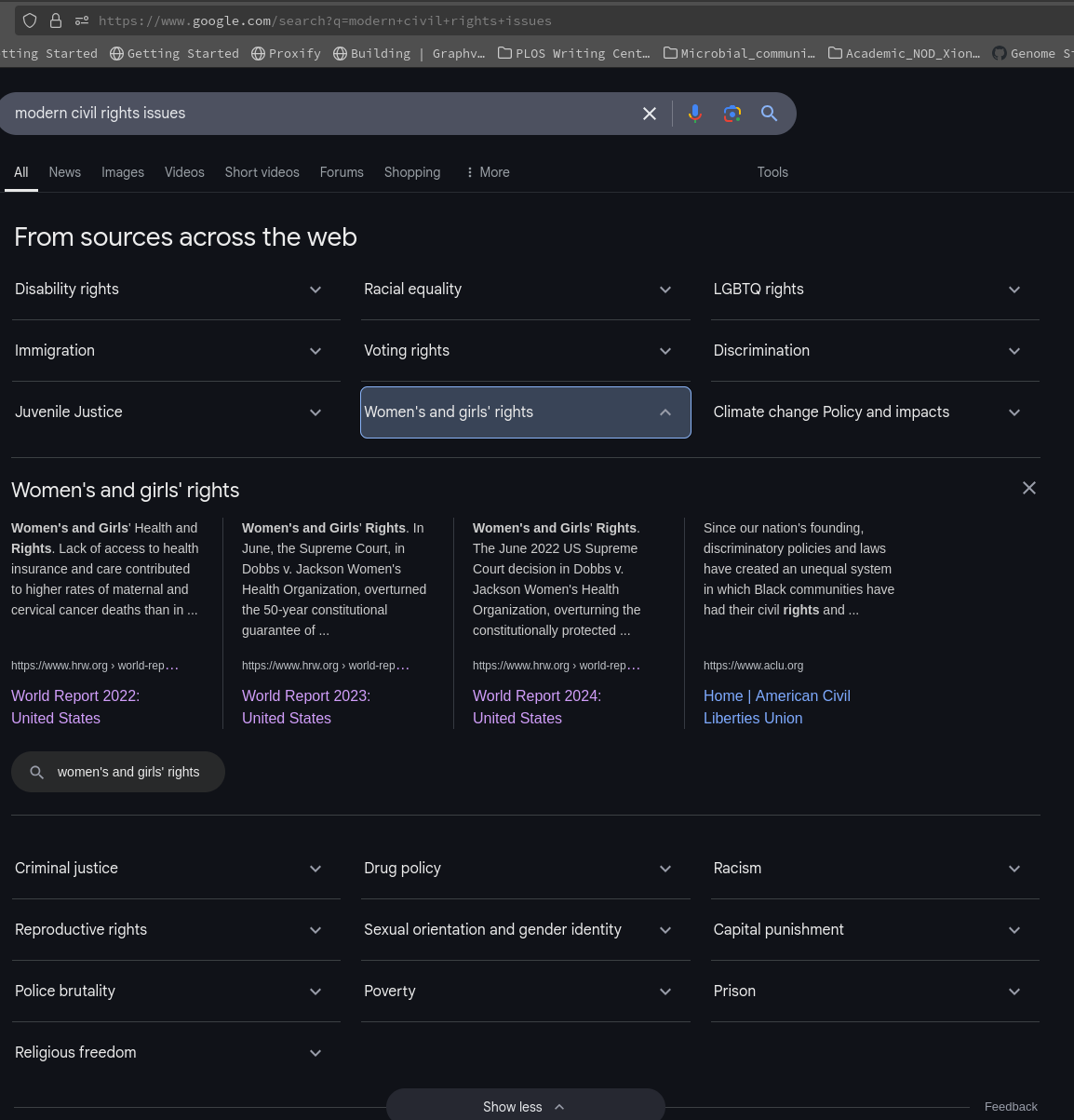 Google search for "modern civil rights issues" displays a helpful menu with 2 sources: ACLU and HRW. for "modern civil rights issues" revealed lackluster pages from Human Rights Watch. Notable events include a 3/2021 Biden administration executive order establishing the White House Gender Policy Council and a 10/2021 "national strategy" on gender equity and equality.
Google search for "modern civil rights issues" displays a helpful menu with 2 sources: ACLU and HRW. for "modern civil rights issues" revealed lackluster pages from Human Rights Watch. Notable events include a 3/2021 Biden administration executive order establishing the White House Gender Policy Council and a 10/2021 "national strategy" on gender equity and equality.
If google search results (fail to) show anything, there are only a handful of organizations taking up the banner of womens' rights. These search results are devastating. Given that women represent, not a minority group at all by definition, but a majority group. Notable stats from the ACLU website include the 0.54 (Latina), 0.64 (African American), and 0.78 cents statistics with no mention of the source of the statistic or when the cited disparity was assessed. They also cite a DoJ stat that 1 in 4 homeless women are so because of violence. Very bad sound bite quality, let alone no reference to the stats or trends. This is one of the banner civil rights groups, the ACLU.
They have one link on their page: a 2019 article of the ACLU vision for gender justice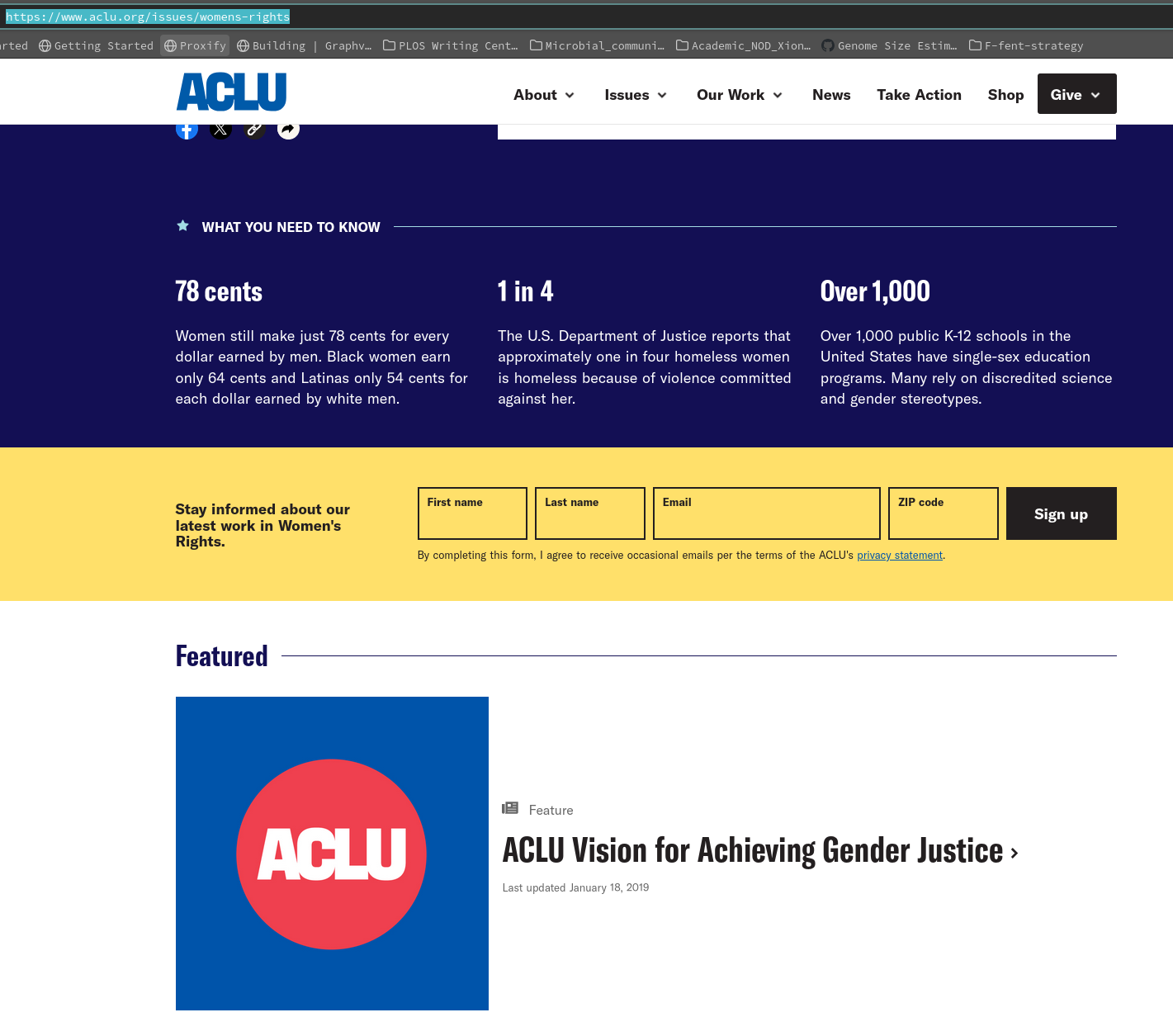 It probably took a few ladies standing on a big limb to get a whole page's content. Eh, let's keep it light though.. Look I'm just mansplaining here, and I really like easy views but I can't stand them if they're from women whatsoever... truth be told I'm no ladies man... but... to me it seems a little off when there isn't a single mention of 'womens' anything on the google search for "modern civil rights issues"
It probably took a few ladies standing on a big limb to get a whole page's content. Eh, let's keep it light though.. Look I'm just mansplaining here, and I really like easy views but I can't stand them if they're from women whatsoever... truth be told I'm no ladies man... but... to me it seems a little off when there isn't a single mention of 'womens' anything on the google search for "modern civil rights issues"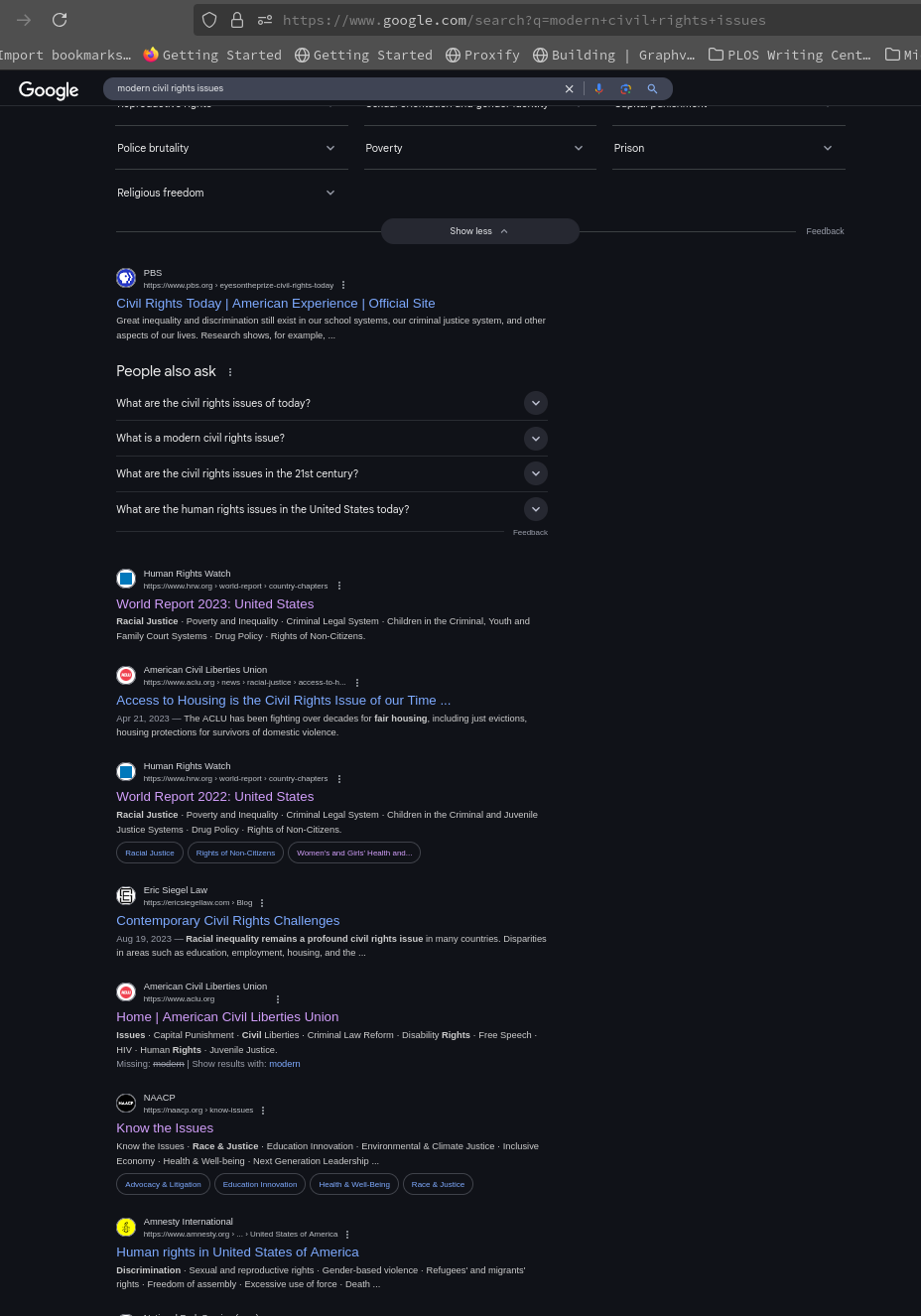 Most top content seems reputable enough... top ranked search results don't include modern women's rights groups or POC women's groups. and most civil liberty sites reference reproductive freedom as the women's right issue. Just pandering here, but... if I was a bookish young women, and I didn't know where the "cool girls"Ima Ima... so we can ruuunn... could talk about womens issues, it wouldn't be on tiktok, or on libsoftiktoks handle. It would be somewhere else deep on the web, and trollXchromosomes is a horrible introduction to the depth that is the duality between good and bad feminine. We're screwed.
Most top content seems reputable enough... top ranked search results don't include modern women's rights groups or POC women's groups. and most civil liberty sites reference reproductive freedom as the women's right issue. Just pandering here, but... if I was a bookish young women, and I didn't know where the "cool girls"Ima Ima... so we can ruuunn... could talk about womens issues, it wouldn't be on tiktok, or on libsoftiktoks handle. It would be somewhere else deep on the web, and trollXchromosomes is a horrible introduction to the depth that is the duality between good and bad feminine. We're screwed.
Racial Equity and Equality
Caucasian households have median household wealth 200%-400% than African Americans or Latino/a households. - data from U.S. Census Bureau and Pew Research graphics, shown below.
According to U.S. Census Bureau July 2023 data, and a U.S. Department of Housing and Urban Development report from the same year, the odds ratio of being homeless is 3x (302.6%) greater if you’re an African American folkperson than compared to non-black ppls in the USA - Matt Ralston, 2025. See calculation footnote.
Black, Latino/a, Indigenous, and Pacific Islander are 300% to 600%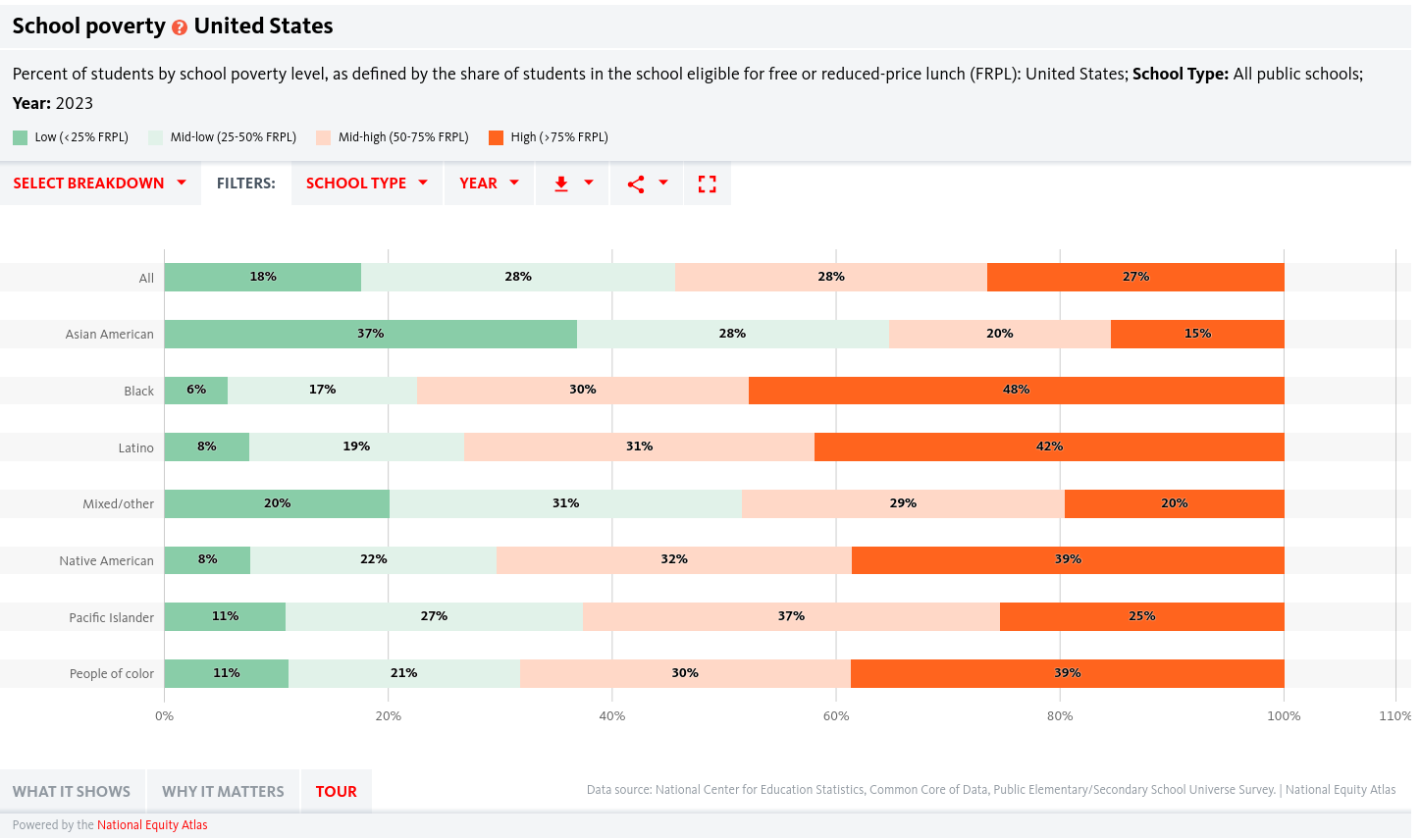 49% of colored students attend a high-poverty school, 12% higher than the national average. Data from National Center for Education Statistics more likely to attend a ‘high-poverty’ K-12 school. I suggest reading the Pew Research
49% of colored students attend a high-poverty school, 12% higher than the national average. Data from National Center for Education Statistics more likely to attend a ‘high-poverty’ K-12 school. I suggest reading the Pew Research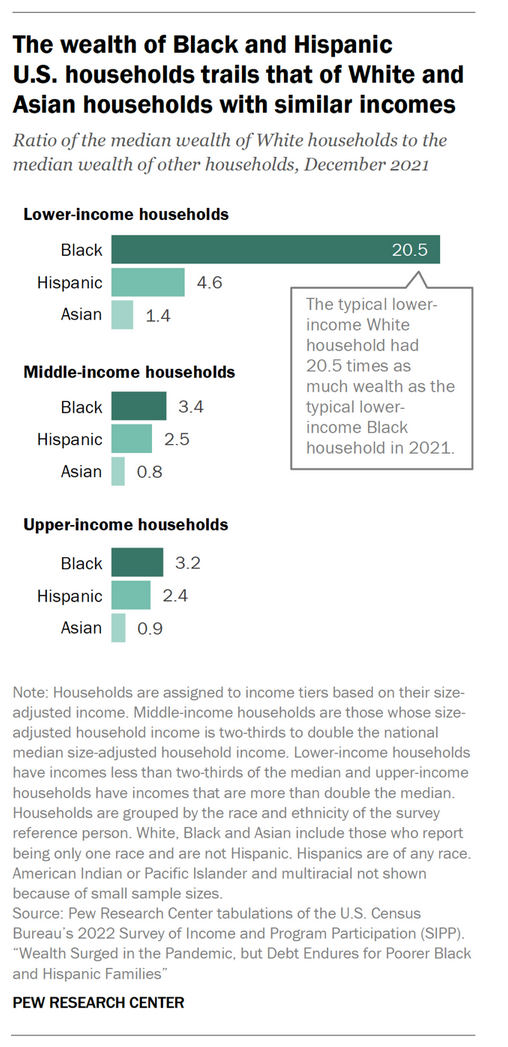 Wealth Ratio, or the number of times a white household’s wealth is larger with respect to a household of color (20.5x = 2,050%) article on wealth gaps.
Wealth Ratio, or the number of times a white household’s wealth is larger with respect to a household of color (20.5x = 2,050%) article on wealth gaps.
Linkes of interest on race equity:
- Human Rights Watch
- National Association for the Advancement of Colored People
- American Civil Liberties Union
This section needs work.
Diversity, Equity, and Inclusion (DEI) - do you have a solution?
You shouldn't. This is a very sensitive, polarizing, and difficult topic for most Americans, all ethnicities included.
DEI has become a controversial topic of the last several years. Many view points exist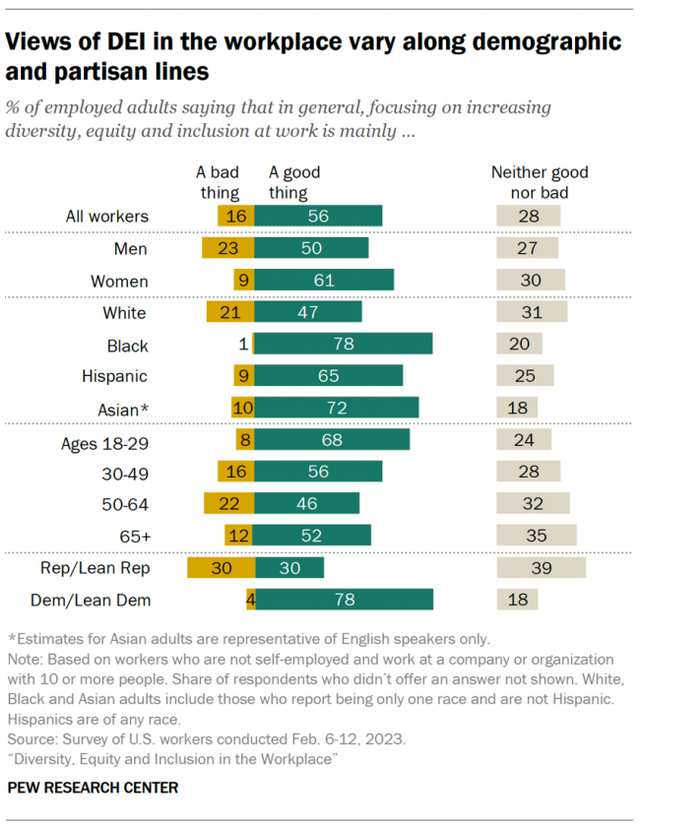 Pew Research 2023 survey, from the dismissive and causally negligent, to outright hateful views
Pew Research 2023 survey, from the dismissive and causally negligent, to outright hateful views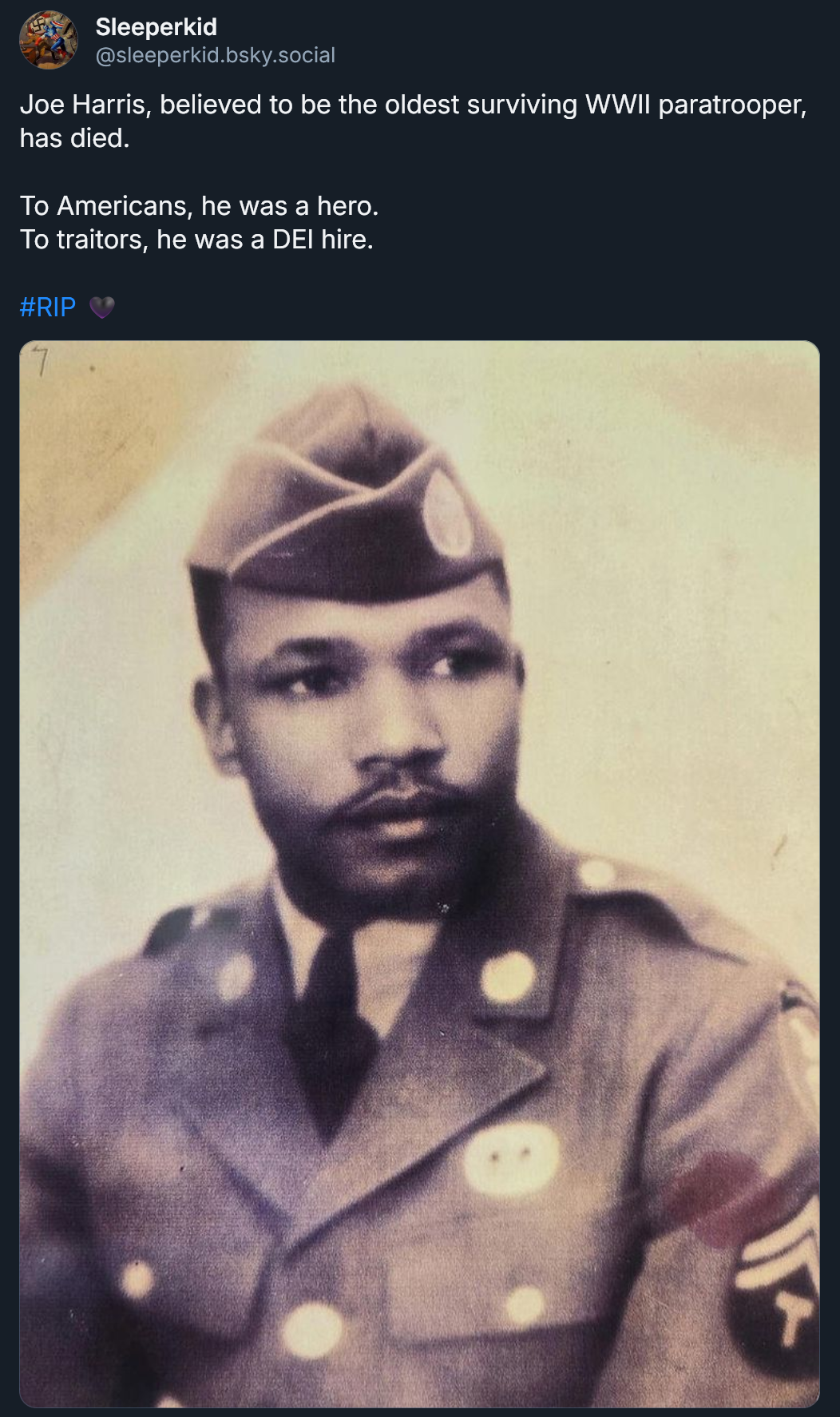 Sergeant Joe Harris - aged 108, died March 15, 2025 of including under-represented persons in media
Sergeant Joe Harris - aged 108, died March 15, 2025 of including under-represented persons in media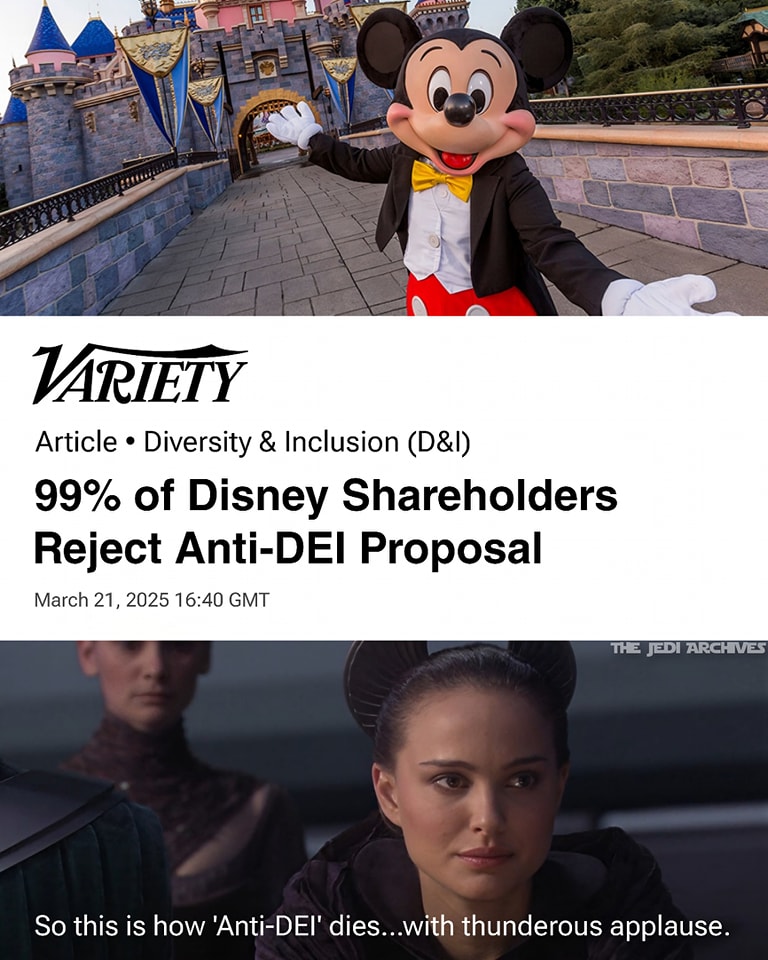 Disney shareholders reject anti-diversity proposal, 3/21/25, marketing, talent-selection pools for hiring, and across appointed and elected positions in government
Disney shareholders reject anti-diversity proposal, 3/21/25, marketing, talent-selection pools for hiring, and across appointed and elected positions in government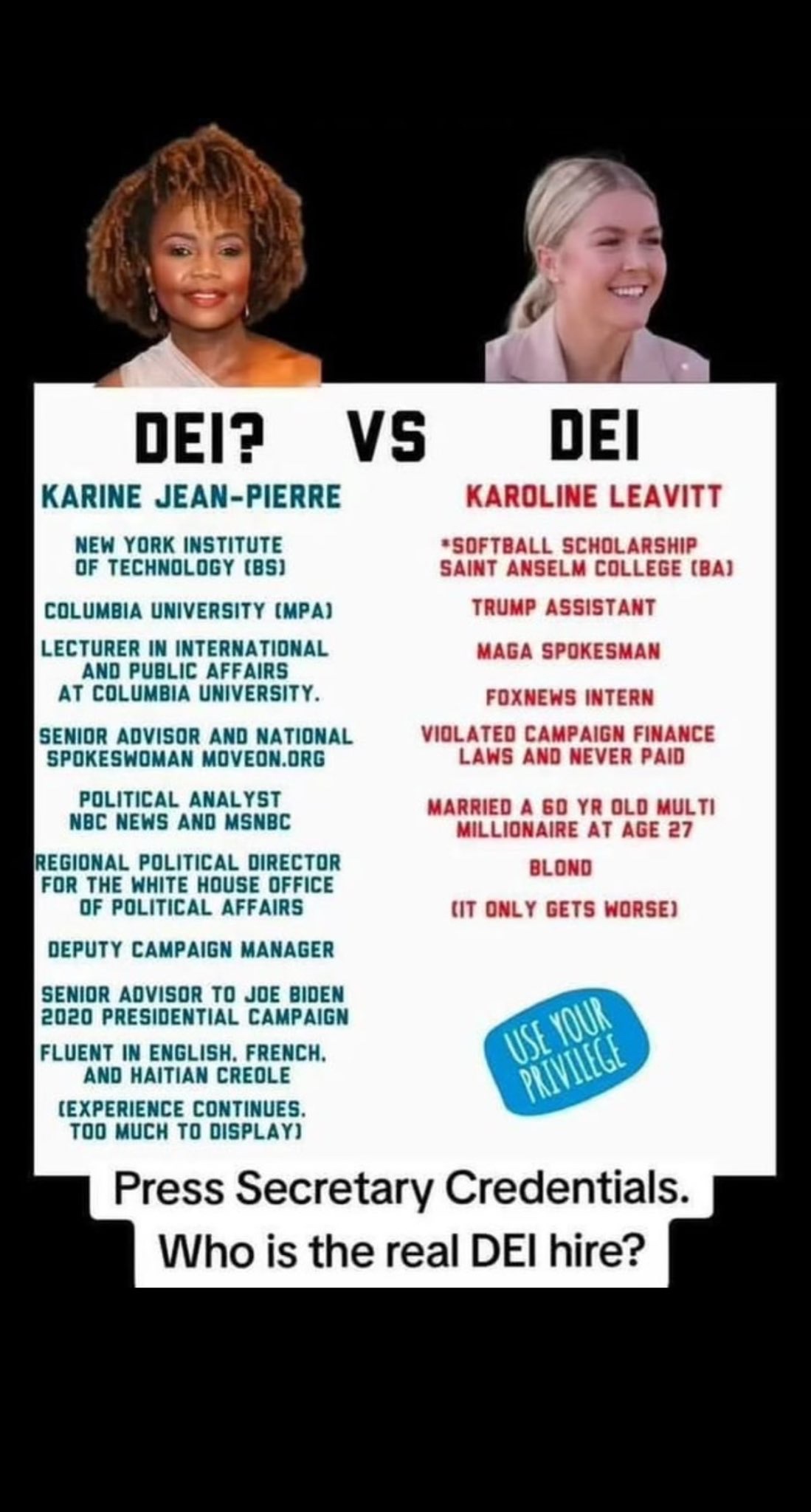 Jarine Jean-Pierre was the 2022 pick for Press Secretary of the U.S.A. Whitehouse in the latter half of the Biden administration. Karoline Leavitt is the 2025 Trump admin Whitehouse Press Secretary, C-suite and board-rooms, and other positions throughout society.
Jarine Jean-Pierre was the 2022 pick for Press Secretary of the U.S.A. Whitehouse in the latter half of the Biden administration. Karoline Leavitt is the 2025 Trump admin Whitehouse Press Secretary, C-suite and board-rooms, and other positions throughout society.
One key issue is not guide decisions by evening the statistics of diversity… that would be racial quotas. This topic is not simple to address or even understand ethically at face value. That said, the key principles for 'DEI hiring Good principle, very difficult in practice. That's all I'm saying…' and affirmative action (or its synonyms "alternative access" and "positive action") was originally designed by both EO. 10925 and the Civil Rights Act of 1964.
Good principle, very difficult in practice. That's all I'm saying…' and affirmative action (or its synonyms "alternative access" and "positive action") was originally designed by both EO. 10925 and the Civil Rights Act of 1964.
Odds-ratio of being homeless and black
What is an odds-ratio? An odds-ratio is a comparison of the odds of being homeless AND black, in comparison to the odds of being homeless and non-black (all other races). If an odds-ratio is less than 1, it suggests that the two factors (black and homelessness) are likely to not relate to one another. However, if the odds-ratio is greater than 1, it may suggest a link between one condition (homelessness) being at greater risk because of another condition (being of African-American racial lineage).
We want to compare the odds of being homeless and black (percent black and homeless over percent black and non-homeless) vs the odds of being homeless and non-black (percent of non-black and homeless over percent non-black and non-homeless). This is called the odds-ratio and in this case it is the propensity for being black and homeless compared to being non-black and homeless.
In the following code block, "p_black" roughly means "percentage of black persons", while "c_black" means "count of black persons".
1
2
3
4
5
6
7
8
9
10
11
12
13
14
15
16
17
18
19
20
21
22
23
24
25
26
27
28
29
30
31
32
33
34
35
36
37
38
39
40
41
42
43
44
45
46
47
48
49
50
51
52
53
54
55
56
57
58
59
60
61
62
63
64
65
66
67
68
69
70
71
72
73
74
75
76
77
78
79
80
81
82
83
84
85
86
87
88
89
90
91
92
93
94
95
96
97
>>> import math
>>> p_black=0.136 # US Census July 1, 2023
>>> p_nonblack=0.864 # US Census July 1, 2023
>>> c_total=341400000 # Mistakenly used 1/25/2025 U.S. Census numbers. We'll come back to that...
>>> c_black=math.floor(p_black*c_total) # Use the floor command to round-down to nearest whole number
>>> c_black
46430400 #46M black persons
>>> c_nonblack=math.floor(c_total-c_black)
294969600 # ~295M non-black persons
>>> p_blackhomeless=0.37 # percentage of persons who are homeless that are also black - Incorrectly reported as 37% by ChatGPT referencing the HUD 2023 Annual Homelessness Assessment report.
>>> c_blackhomeless=math.floor(p_homeless*c_black)
17179248
>>> p_homeless=0.0023 # This came from USAFact (unknown timing of sample) via ChatGPT. Official HUD percentage is 0.1913%
>>> c_homeless=math.floor(p_homeless*c_total)
>>> c_homeless
785220
>>> c_homeless_hud_2023=653104 # This lower number of count of homeless persons is from the HUD Annual Report in 2023
>>> p_homeless_estimate=c_homeless_hud_2023 / c_total # Official HUD homeless counts compared to July Census 2023
0.0019130169888693614 # Compared to 0.23 % reported when accessed differently
>>> p_blackhomeless # Not the same at all as p_homeless_estimate... do you understand why that is?
0.37 # This is the percentage of homeless persons who are black.
>>> p_blackhomeless*c_homeless_hud_2023
241648.48
>>> c_homeless # Slightly different homelessness counts, both according to the HUD 2023 report from different research sources. Weird. I will use c_homeless_hud_2023 going forward.
785220
>>> c_homeless_hud_2023
653104
>>> c_homeless/c_total # EXACT MATCH! Right on... we'll see why this is bad in a minue...
0.0023
>>> c_total=334900000 # [Corrected] for 2023 Census numbers
>>> c_homeless/c_total # Well... weird.. wonder what's going on...
0.0023446401911018213
>>> c_homeless_hud_2023 / c_total # HUD 2023 numbers divided by *corrected* total US Citizen census count.
0.0019501463123320394 # Correct percentage of homeless according to 2023 U.S. Census numbers for total U.S. Citizens and the count of homeless according to HUD 2023 Annual Homelessness Report
>>> p_blackhomeless_hud_2023=0.322 # I don't know what I was doing here... it won't matter. If you follow through you'll see why in a moment
>>> p_blackhomeless_hud_2023 # Oh, wait... now I remember... this is the corrected percentage (not 37%) from U.S. HUD Annual Homelessness Assessment Report 2023.
0.322
>>> odds_black_and_homeless=p_blackhomeless_hud_2023/((c_black-c_blackhomeless_hud_2023)/c_black) # I'm really trying here... but something isn't right quite yet.
>>> odds_black_and_homeless
0.323465082865137 # Nah, this is incorrect. We'll see why in a second.
>>> c_nonblackhomeless_hud_2023 = c_homeless - c_blackhomeless # Also wrong! I correct this in a few lines. c_homeless is 785220 here, overestimated.
>>> c_nonblackhomeless_hud_2023 # This came from the original c_homeless , which was 0.0023 * 341.4M 2025 Census numbers written on my chalkboard. I corrected c_total above but have not redefined this variable yet, so the count is higher than it should be.
574921
>>> c_blackhomeless_hud_2023
210299
>>> c_homeless_hud_2023 # CORRECT number from page 24, Exhibit 2.1 in HUD 2023 Annual Homelessness Assessment report.
653104
>>> c_nonblackhomeless_hud_2023 = c_homeless_hud_2023 - c_blackhomeless_hud_2023 # Corrected black and homeless count.
>>> c_blackhomeless_hud_2023 + c_nonblackhomeless_hud_2023 == c_homeless_hud_2023
True # (pointless) verification
>>> c_nonblackhomeless_hud_2023 # Homeless and non-black
442805 # MUCH BETTER. This is from the smaller
>>> c_blackhomeless_hud_2023 # Homeless and black
210299
>>> p_nonblackhomeless_hud_2023
0.6780007472010583
>>> odds_nonblack_and_homeless=c_nonblackhomeless_hud_2023/c_nonblack # 0.15% Of US population is homeless and non-black by dividing the HUD 2023 homeless and non-black (442805) by July U.S. Census 2023 non-African American persons count (~295M)
0.0015011885970622058 # This should be p_nonblackhomeless, not odds
# This isn't right... this would make the odds ratio 215x ... reworking
>>> c_black_not_homeless = c_black-c_blackhomeless_hud_2023
46220101
>>> p_black_not_homeless = c_black_not_homeless/c_black
0.9954706614631793 # looks good
# At this point p_blackhomeless_hud_2023 refers to the proportion of homeless who are black ~32.2%
>>> p_nonblackhomeless=c_nonblackhomeless_hud_2023/c_nonblack
0.0015011885970622058
# OKAY so far so good... ish. Let's redefine some variables
>>> p_homeless_who_are_black=p_blackhomeless
0.37
>>> p_blackhomeless=c_blackhomeless_hud_2023/c_black
0.004529338536820703
>>> p_homeless_who_are_black # Notice this is still referring to the ChatGPT misquote of blac homelessness proportion.
0.37
>>> c_nonblackhomeless_hud_2023
442805
>>> c_blackhomeless_hud_2023
210299
>>> c_homeless_who_are_nonblack = c_homeless_hud_2023-c_blackhomeless_hud_2023
>>> c_homeless_who_are_nonblack
442805
>>> p_homeless_who_are_nonblack
0.6780007472010583
>>> p_nonblackhomeless = c_nonblackhomeless_hud_2023/c_nonblack
>>> p_nonblackhomeless
0.0015011885970622058 # Cool. Now are homelessness rates are similar
>>> p_blackhomeless
0.004529338536820703
>>> odds_black_and_homeless = p_blackhomeless/((c_black-c_blackhomeless_hud_2023)/c_black)
>>> odds_black_and_homeless
0.004549946786139649 # Note the difference between p_blackhomeless and odds_black_and_homeless
>>> odds_nonblack_and_homeless = p_nonblackhomeless/((c_nonblack-c_nonblackhomeless_hud_2023)/c_nonblack)
>>> odds_nonblack_and_homeless
0.0015034455523817451
>>> odds_ratio = odds_black_and_homeless/odds_nonblack_and_homeless
3.026346234442387 # This looks like the correct number
Sources:
Jill Khadduri, Tanya de Sousa, Alyssa Andrichik, Ed Prestera, Katherine Rush, Colette Tano, and Micaiah Wheeler, and Abt Associates, U.S. Department of Housing and Urban Development. (2023). Annual Homeless Assessment Report (AHAR) to Congress: 2023, p24
U.S. Census Bureau, “Population Estimates”. July 1, 2023. https://www.census.gov/quickfacts/fact/table/US/PST045223
Full Python session included in the markdown file as a comment.
